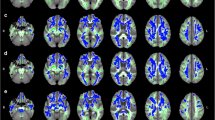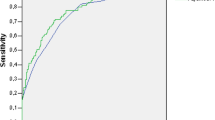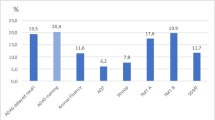Abstract
Marked cerebral white matter changes are a frequent finding in the daily routine of magnetic resonance imaging of elderly patients. These findings are often equated with a decrease of cognitive function. Here we present a case of massive white matter changes but excellent cognitive performance, to avoid the automatism of drawing conclusions on intellectual ability by just interpreting the imaging data of elderly patients.

Similar content being viewed by others
Notes
The SIENA software is part of FSL-FMRIB′s Software Library (http://www.fmrib.ox.ac.uk/fsl)
References
Joutel A, Chabriat H, Vahedi K, Domenga V, Vayssiere C, Ruchoux MM, Lucas C, Leys D, Bousser MG, Tournier-Lasserve E (2000) Splice site mutation causing a seven amino acid Notch3 in-frame deletion in CADASIL. Neurology 9:1874–1875
Smith SM, Zhang Y, Jenkinson M, Chen J, Matthews PM, Federico A, et al (2002) Accurate, robust, and automated longitudinal and cross-sectional brain change analysis. Neuroimage 17:479–489
Poeck K (1989) Apraxie [Apraxia]. In: Poeck K (ed) Klinische Neuropsychologie [Clinical Neuropsychology]. Thieme, Stuttgart, pp 188–207
Hachinski VC, Potter P, Merskey H (1987) Leuko-araiosis. Arch Neurol 44:21–23
Garde E, Mortensen EL, Krabbe K, Rostrup E, Larsson HB (2000) Relation between age-related decline in intelligence and cerebral white-matter hyperintensities in healthy octogenarians: a longitudinal study. Lancet 356:628–634
De Groot JC, De Leeuw FE, Oudkerk M, van Gijn J, Hofman A, Jolles J, et al (2002) Periventricular cerebral white matter lesions predict rate of cognitive decline. Ann Neurol 52:335–341
Breteler MM, van Swieten JC, Bots ML, Grobbee DE, Claus JJ, van den Hout JH, et al (1994) Cerebral white matter lesions, vascular risk factors, and cognitive function in a population-based study: the Rotterdam study. Neurology 44:1246–1252
Prencipe M, Marini C (1989) Leuko-araiosis: definition and clinical correlates—an overview. Eur Neurol 29:27–29
Udaka F, Sawada H, Kameyama M (2002) White matter lesions and dementia: MRI-pathological correlation. Ann N Y Acad Sci 977:411–415
Longstreth WT Jr, Manolio TA, Arnold A, Burke GL, Bryan N, Jungreis CA, et al (1996) Clinical correlates of white matter findings on cranial magnetic resonance imaging of 3301 elderly people. The Cardiovascular Health Study. Stroke 27:1274–1282
Stern Y (2002) What is cognitive reserve? Theory and research application of the reserve concept. J Int Neuropsychol Soc 8:448–460
Scarmeas N, Stern Y (2004) Cognitive reserve: implications for diagnosis and prevention of Alzheimer’s disease. Curr Neurol Neurosci Rep 4:374–380
Berkman LF, Glass T, Brissette I, Seeman TE (2000) From social integration to health: Durkheim in the new millennium. Soc Sci Med 51:843–857
Meguro K, Shimada M, Yamaguchi S, Ishizaki J, Ishii H, Shimada Y, Sato M, Yamadori A, Sekita Y (2001) Cognitive function and frontal lobe atrophy in normal elderly adults: Implications for dementia not as aging-related disorders and the reserve hypothesis. Psychiatry Clin Neurosci 55:565–572
Churchill JD, Galvez R, Colcombe S, Swain RA, Kramer AF, Greenough WT (2002) Exercise, experience and the aging brain. Neurobiol Aging 23:941–955
Fillit HM, Butler RN, O’Connell AW, Albert MS, Birren JE, Cotman CW, et al (2002) Achieving and maintaining cognitive vitality with aging. Mayo Clin Proc 77:681–696
van Praag H, Kempermann G, Gage FH (2000) Neural consequences of environmental enrichment. Nat Rev Neurosci 1:191–198
Fratiglioni L, Paillard-Borg S, Winblad B (2004) An active and socially integrated lifestyle in late life might protect against dementia. Lancet Neurol 3:343–353
Zekry D, Duyckaerts C, Moulias R, Belmin J, Geoffre C, Herrmann F, Hauw JJ (2002) Degenerative and vascular lesions of the brain have synergistic effects in dementia of the elderly. Acta Neuropathol 103:481–487
Oswald DW, Fleischmann UM, Keuchel (1983) Psychometrics in the treatment of ischemic cerebrovascular diseases. Eur Neurol 22:61–67
Helmstaedter C, Durwen HF (1990) The verbal learning and retention test. A useful and differentiated tool in evaluating verbal memory performance. Schweiz Arch Neurol Psychiatr 141:21–30
Rey A (1941) L’examen clinique psychologique dans les cas d‘encéphalopathie traumatic. Arch Psychol 28: 286–340
Osterrieth PA (1944) Le test de copie d’une figure complexe. Arch Psychol 30:206–356
Acknowledgements
This work was supported by the NRW-Nachwuchsgruppe Kn2000 of the Nordrhein-Westfalen Ministry of Education and Research (Fö.1KS9604/0), the Interdisciplinary Centre of Clinical Research, Münster (IZKF Projects FG2 and Kne3/074/04), the Innovative Medizinische Forschung, Münster (KN520301), the Deutsche Forschungsgemeinschaft (Kn 285/6–1 and 6–3) as well as a Marie Curie Research and Training grant (RTN:LAB 512141), Mednet Atrial Fibrillation BMBF, and the Neuromedical Foundation.
Author information
Authors and Affiliations
Corresponding author
Rights and permissions
About this article
Cite this article
Duning, T., Kugel, H. & Knecht, S. Excellent cognitive performance despite massive cerebral white matter changes. Neuroradiology 47, 749–752 (2005). https://doi.org/10.1007/s00234-005-1420-6
Received:
Accepted:
Published:
Issue Date:
DOI: https://doi.org/10.1007/s00234-005-1420-6




